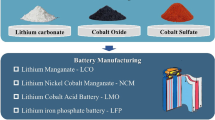Abstract
We analyze the problem of preventing biological invasions caused by ships transporting internationally traded goods between countries and continents. Specifically, we ask the following question: should a port manager have a small number of inspectors inspect arriving ships less stringently or should this manager have a large number of inspectors inspect the same ships more stringently? We use a simple queuing-theoretic framework and show that if decreasing the economic cost of regulation is very important then it makes more sense for the port manager to choose the less stringent inspection regime. In contrast, if reducing the damage from biological invasions is more salient then the port manager ought to pick the more stringent inspection regime.
Similar content being viewed by others
Notes
As Batabyal and Beladi (2004) have noted, the primary method of marine alien species introduction is through the dumping of ballast water. Cargo ships generally carry ballast water in order to increase vessel stability when they are not carrying full loads. When these ships come into port, this ballast water must be discharged before cargo can be loaded. It is estimated that over 4,000 species of invertebrates, algae, and fishes are being moved around the world in ship ballast tanks every day. Consider the case of Canada. It has been estimated that as much as 13 billion gallons or 50 million metric tonnes of overseas ballast water enters Canadian coastal ports every year. A recent analysis by the Smithsonian Environmental Research Center (SERC) in Edgewater, Maryland computed that a liter of ballast water generally contains several billion organisms similar to viruses and up to 800 million bacteria. Two web sites that provide useful information on these issues are http://www.fundyforum.com/profile_archives and http://www.serc.si.edu
It should be noted that different modeling techniques involve different cross space and time variation features for the underlying physical processes and the associated uncertainties.
This result is important because it relates two important metrics in queuing models, i.e., the average queue size and the average customer waiting time in the stationary state. In the context of our paper, the average queue size is the average number of ships in our port system and the average customer waiting time is our AWS criterion.
References
Barbier EB (2001) A note on the economics of biological invasions. Ecol Econ 39:197–202
Batabyal AA, Beladi H (2004) International trade and biological invasions: a queuing theoretic analysis of the prevention problem. Eur J Oper Res (in press)
Batabyal AA (2004) A research agenda for the study of the regulation of invasive species introduced unintentionally via maritime trade. J Econ Res 9:191–216
Cox GW (1993) Conservation ecology. WC Brown Publishers, Dubuque
Eiswerth ME, Johnson WS (2002) Managing nonindigenous invasive species: insights from dynamic analysis. Environ Res Econ 23:319–342
Eiswerth ME, van Kooten GC (2002) Uncertainty, economics, and the spread of an invasive plant species. Am J Agric Econ 84:1317–1322
Heywood V (ed) (1995) Global biodiversity assessment. Cambridge University Press, Cambridge
Horan RD, Perrings C, Lupi F, Bulte EH (2002) Biological pollution prevention strategies under ignorance: the case of invasive species. Am J Agric Econ 84:1303–1310
Office of Technology Assessment (OTA) (1993) Harmful non-indigenous species in the United States. OTA-F-565, Washington
Olson LJ, Roy S (2002) The economics of controlling a stochastic biological invasion. Am J Agric Econ 84:1311–1316
Parker IM, Simberloff D, Lonsdale WM, Goodell K, Wonham M, Kareiva PM, Williamson MH, Von Holle B, Moyle PB, Byers JE, Goldwasser L (1999) Impact: toward a framework for understanding the ecological effects of invaders. Biol Invasions 1:3–19
Perrault AM, Muffett WC (2002) Turning off the tap: a strategy to address international aspects of invasive alien species. Rev Eur Community Int Environ Law 11:211–224
Perrings C, Williamson M, Dalmazzone S (2000) Introduction. In: Perrings C, Williamson M, Dalmazzone S (eds) The economics of biological invasions. Edward Elgar, Cheltenham, p 11
Pimentel D, Lach L, Zuniga R, Morrison D (2000) Environmental and economic costs of nonindigenous species in the United States. BioScience 50:53–65
Ross SM (2003) Introduction to probability models, 8th edn. Academic, San Diego, pp 480–483
Settle C, Shogren JF (2004) Modeling native-exotic species within Yellowstone lake. Am J Agric Econ 84:1323–1328
Taylor HM, Karlin S (1998) An introduction to stochastic modeling, 3rd edn. Academic, San Diego
Vitousek PM, D’Antonio CM, Loope LL, Westbrooks R (1996) Biological invasions as global environmental change. Am Scientist 84:468–478
Wolff RW (1989) Stochastic modeling and the theory of queues. Prentice-Hall, Englewood Cliffs
Acknowledgments
We thank George Christakos and two anonymous referees for their constructive comments on a pervious version of this paper. In addition, Batabyal acknowledges financial support from the USDA’s PREISM program by mean of cooperative Agreement 43-3AEM-4-80100 and from the Gosnell endowment at RIT. The usual disclaimer applies.
Author information
Authors and Affiliations
Corresponding author
Rights and permissions
About this article
Cite this article
Batabyal, A.A., Beladi, H. & Koo, W.W. Maritime trade, biological invasions, and the properties of alternate inspection regimes. Stoch Environ Res Ris Assess 19, 184–190 (2005). https://doi.org/10.1007/s00477-004-0216-2
Published:
Issue Date:
DOI: https://doi.org/10.1007/s00477-004-0216-2




